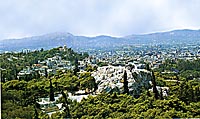The Council of Five Hundred was a representative body that was not based on political parties (as in contemporary democracies), but on the geographic position of the citizensí place of residence. It participated indirectly in the legislative process as a committee, which examined closely the cases that were sent to the Assembly before it convened.
Executive power was allocated to the archons, who were usually selected by lot and controlled by the Council. They were liable either to the Council or to the Assembly. In cases of criminal responsibility the archons were tried by Heliaia (the popular assembly organised into a court of 6,001 men). | 



